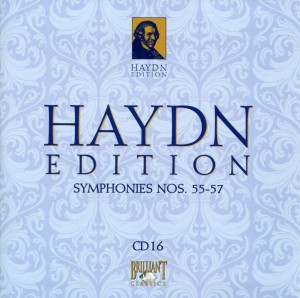 Today’s Haydn CD seems brighter, livelier, more fun.
Today’s Haydn CD seems brighter, livelier, more fun.
Or, maybe, it’s my change of venue. I decided to listen and post in Barnes & Noble on this cloudy-and-chilly October morning.
Whatever it is, Symphony No. 55 in E Flat “Der Schulmeister” sounds rather Mozart like.
Not to belittle Haydn’s talents. But this particular symphony has a bouncier, more playful feel to it, more like something Mozart might have written. (By the way, in 1774 Mozart was 18. By that point in his life, Amadeus had probably written a gazillion symphonies. So, my guess is Haydn and Mozart — who knew each other — might have been playing a bit of friendly competition, much like Paul McCartney and Brian Wilson did in the mid 1960s.)
 Composed in 1774 (Haydn was 42), Symphony No. 55 is another of Haydn’s symphonies with a nickname, this time “The Schoolmaster.” Again, the origin of that nickname appears unknown. According to its entry on Wiki:
Composed in 1774 (Haydn was 42), Symphony No. 55 is another of Haydn’s symphonies with a nickname, this time “The Schoolmaster.” Again, the origin of that nickname appears unknown. According to its entry on Wiki:
H. C. Robbins Landon notes that while Haydn’s autograph manuscript of the symphony contains no reference to this title, the work has been known by this name since the early nineteenth century. Landon suggests that the dotted rhythm of the second movement calls to mind the wagging finger of a schoolmaster, and points out that in the catalog of his works that Haydn helped prepare in the final years of his life, there is a fragment of a lost Divertimento in D containing a similar dotted rhythm entitled “Der verliebte Schulmeister” (the schoolmaster in love). Landon goes on to propose a program for the symphony’s second movement in which the sections marked semplice represent the “strict, pedantic” teacher and the dolce sections depict the same teacher overwhelmed by love.
I thought the “dotted rhythm” of Movement II (“Adagio, ma semplicemente”) sounded like the rhythm of the lyrics in the Lerner and Loewe song “Ascot Gavotte” from the film version of My Fair Lady, my second favorite musical (after Singin’ in the Rain). Check it out:
Now, listen to Haydn’s Symphony No. 55. Start playing the clip at the 5:32 mark and compare to the above:
See?
I doubt Haydn took a page from Lerner and Loewe. So it must be the other way around. Or, my ears are clogged and I’m not hearing accurately.
Whatever.
I’ve been known to be wrong. For example, to prove the adage “beauty is in the eye of the beholder,” (or, the far less elegant, “opinions are like a-holes; everybody has one”), the entry on AllMusic for this symphony says this:
Composed in 1774, this work is among the most conservative and least adventurous of Franz Josef Haydn’s symphonies in the period between 1771-1774.
Hmm. I liked this symphony from start to finish (especially Movement IV — “Finale: Presto”). I thought this symphony was one of his best. Shows you what I know.
Symphony No. 56 in C was composed in 1774. Haydn was 44. It, again, begins with spirit and verve. Movement I (“Allegro di molto”) grabbed me from the start. The real gem of Symphony No. 56, however, is the last, Movement IV (“Prestissimo” — “even faster than presteo”). I love reckless abandon of it. It just dashes forward.
Symphony No. 57 in D, also composed in 1774, is another good symphony. But nothing in it jumps out at me. In fact, because Movement I is “adagio – allegro” (with too much emphasis on the adagio for my tastes), it doesn’t immediately gain my attention. Overall, on a scale of 1-10, I’d give Symphony No. 57 a 4. (And I’m aware that I’ll likely burn in hell for suggesting Haydn symphony only rated a 4. But what can I say? I like hot places.)

You’re not crazy, it sounds a lot like Ascot Gavotte to me, too!
Thank you. I thought so! Obviously Lerner and Loewe were fans of Haydn.